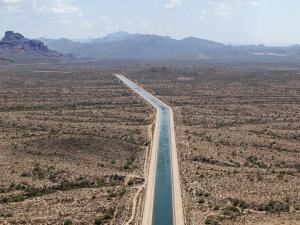
The Colorado River Basin is experiencing diminished flows in its rivers and streams. This story map explains how satellite data can measure changes in total water storage, a new and efficient means of measuring groundwater changes.
The Colorado River is a vital water source for 40 million people across seven U.S. states and Mexico, supporting cities, farms, energy production, and ecosystems. Long-term drought and historic over allocation have severely strained the river, leading to potential water shortages for agriculture, cities, and tribes in Arizona.

The Colorado River Basin is experiencing diminished flows in its rivers and streams. This story map explains how satellite data can measure changes in total water storage, a new and efficient means of measuring groundwater changes.

The Arizona Colorado River Visualization Enterprise (CuRVE) is an interactive tool for exploring how Colorado River supplies are used in Arizona, the impacts of Colorado River shortage and water users' options for responding to future cuts in supply.

Understand how Colorado River supply cuts will impact residential water use, groundwater pumping, utility costs, urban growth and economic development in central Arizona.

Central Arizona cities, towns and industries that rely on water conveyed via the Central Arizona Project anticipate future cuts in response to declining Colorado River supplies. But cuts will not be felt equally across all users. This tool provides reasonable estimates of how Colorado River shortages will impact individual communities and other entities.

Learn the story of Arizona’s water, past and present: where it comes from, how it’s used and what challenges lie ahead.

The prospect of deeper cuts of Colorado River supplies looms for Arizona water users. This report explains what those cuts will mean for water availability, water prices, growth and the economy.
This primer discusses the impacts of Colorado River shortages on tap water supplies in Central Arizona to assist stakeholders in assessing measures to adapt to those shortages.
"Assigned water" -- that is, water banking in Lake Mead -- helps keep up reservoir levels, but it also involves trade-offs. This report explores assigned water and whether it undermines the goal of reducing total Colorado River water use over the long term.

Many cities, Tribes and industries in Maricopa, Pinal and Pima Counties use Colorado River water delivered via the Central Arizona Project canal. These water users face a likelihood of cuts to their Colorado River supplies, but the extent of cuts to any particular user varies depending on the priority pools to which they have access. This tool shows how each of these users' access to Colorado River water will be impacted by future cuts.